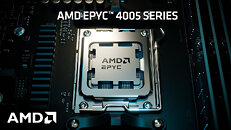Vultr, the world's largest privately-held cloud infrastructure company, today announced that it is one of the first cloud providers to
offer the new AMD EPYC 4005 Series processors. The AMD EPYC 4005 Series processors will be available on the Vultr platform, enabling enterprise-class features and leading performance for businesses and hosted IT service providers. The AMD EPYC 4005 Series processors extend the broad AMD EPYC processor family, powering a new line of cost-effective systems designed for growing businesses and hosted IT services providers that demand performance, advanced technologies, energy efficiency, and affordability. Servers featuring the high-performance
AMD EPYC 4005 Series CPUs with streamlined memory and I/O feature sets are designed to deliver compelling system price-to-performance metrics on key customer workloads. Meanwhile, the combination of up to 16 SMT-capable cores and DDR5 memory in the AMD EPYC 4005 Series processors enables smooth execution of business-critical workloads, while maintaining the thermal and power efficiency characteristics crucial for affordable compute environments.
"Vultr is committed to delivering the most advanced cloud infrastructure with unrivaled price-to-performance," said J.J. Kardwell, CEO of Vultr. "The AMD EPYC 4005 Series provides straightforward deployment, scalability, high clock speed, energy efficiency, and best-in-class performance. Whether you are a business striving to scale reliably or a developer crafting the next groundbreaking innovation, these solutions are designed to deliver exceptional value and meet demanding requirements now and in the future." Vultr's launch of systems featuring the AMD EPYC 4245P and AMD EPYC 4345P processors will expand the company's robust line of Bare Metal solutions. Vultr will also feature the AMD EPYC 4345P as part of its High Frequency Compute (HFC) offerings for organizations requiring the highest clock speeds and access to locally-attached NVMe storage.













































































